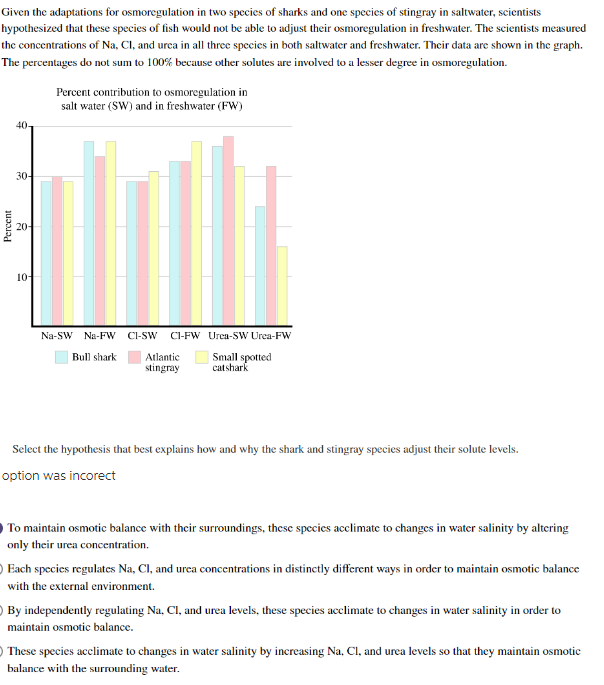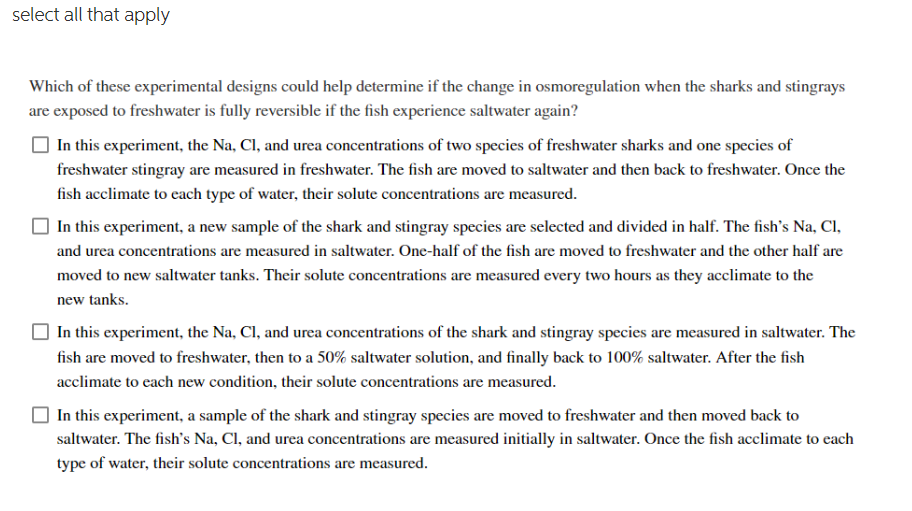select all that apply Which of these experimental designs could help determine if the change in osmoregulation when the sharks and stingrays are exposed to freshwater is fully reversible if the fish experience saltwater again? In this experiment, the Na, Cl, and urea concentrations of two species of freshwater sharks and one species of freshwater stingray are measured in freshwater. The fish are moved to saltwater and then back to freshwater. Once the fish acclimate to each type of water, their solute concentrations are measured. In this experiment, a new sample of the shark and stingray species are selected and divided in half. The fish's Na, Cl, and urea concentrations are measured in saltwater. One-half of the fish are moved to freshwater and the other half are moved to new saltwater tanks. Their solute concentrations are measured every two hours as they acclimate to the new tanks. In this experiment, the Na, Cl, and urea concentrations of the shark and stingray species are measured in saltwater. The fish are moved to freshwater, then to a 50% saltwater solution, and finally back to 100% saltwater. After the fish acclimate to each new condition, their solute concentrations are measured. In this experiment, a sample of the shark and stingray species are moved to freshwater and then moved back to saltwater. The fish's Na, Cl, and urea concentrations are measured initially in saltwater. Once the fish acclimate to each type of water, their solute concentrations are measured.
select all that apply Which of these experimental designs could help determine if the change in osmoregulation when the sharks and stingrays are exposed to freshwater is fully reversible if the fish experience saltwater again? In this experiment, the Na, Cl, and urea concentrations of two species of freshwater sharks and one species of freshwater stingray are measured in freshwater. The fish are moved to saltwater and then back to freshwater. Once the fish acclimate to each type of water, their solute concentrations are measured. In this experiment, a new sample of the shark and stingray species are selected and divided in half. The fish's Na, Cl, and urea concentrations are measured in saltwater. One-half of the fish are moved to freshwater and the other half are moved to new saltwater tanks. Their solute concentrations are measured every two hours as they acclimate to the new tanks. In this experiment, the Na, Cl, and urea concentrations of the shark and stingray species are measured in saltwater. The fish are moved to freshwater, then to a 50% saltwater solution, and finally back to 100% saltwater. After the fish acclimate to each new condition, their solute concentrations are measured. In this experiment, a sample of the shark and stingray species are moved to freshwater and then moved back to saltwater. The fish's Na, Cl, and urea concentrations are measured initially in saltwater. Once the fish acclimate to each type of water, their solute concentrations are measured.
Human Physiology: From Cells to Systems (MindTap Course List)
9th Edition
ISBN:9781285866932
Author:Lauralee Sherwood
Publisher:Lauralee Sherwood
Chapter14: The Urinary System
Section: Chapter Questions
Problem 1SQE
Related questions
Question
please help

Transcribed Image Text:Given the adaptations for osmoregulation in two species of sharks and one species of stingray in saltwater, scientists
hypothesized that these species of fish would not be able to adjust their osmoregulation in freshwater. The scientists measured
the concentrations of Na, Cl, and urea in all three species in both saltwater and freshwater. Their data are shown in the graph.
The percentages do not sum to 100% because other solutes are involved to a lesser degree in osmoregulation.
Percent contribution to osmoregulation in
salt water (SW) and in freshwater (FW)
40-
30-
Na-SW Na-FW
CI-SW CI-FW Urea-SW Urea-FW
Bull shark
Atlantic
stingray
Small spotted
catshark
Select the hypothesis that best explains how and why the shark and stingray species adjust their solute levels.
option was incorect
To maintain osmotic balance with their surroundings, these species acclimate to changes in water salinity by altering
only their urea concentration.
Each species regulates Na, Cl, and urea concentrations in distinctly different ways in order to maintain osmotic balance
with the external environment.
By independently regulating Na, Cl, and urea levels, these species acclimate to changes in water salinity in order to
maintain osmotic balance.
These species acclimate to changes in water salinity by increasing Na, Cl, and urea levels so that they maintain osmotic
balance with the surrounding water.
Percent
20-
10-

Transcribed Image Text:select all that apply
Which of these experimental designs could help determine if the change in osmoregulation when the sharks and stingrays
are exposed to freshwater is fully reversible if the fish experience saltwater again?
In this experiment, the Na, Cl, and urea concentrations of two species of freshwater sharks and one species of
freshwater stingray are measured in freshwater. The fish are moved to saltwater and then back to freshwater. Once the
fish acclimate to each type of water, their solute concentrations are measured.
In this experiment, a new sample of the shark and stingray species are selected and divided in half. The fish's Na, Cl,
and urea concentrations are measured in saltwater. One-half of the fish are moved to freshwater and the other half are
moved to new saltwater tanks. Their solute concentrations are measured every two hours as they acclimate to the
new tanks.
In this experiment, the Na, Cl, and urea concentrations of the shark and stingray species are measured in saltwater. The
fish are moved to freshwater, then to a 50% saltwater solution, and finally back to 100% saltwater. After the fish
acclimate to each new condition, their solute concentrations are measured.
In this experiment, a sample of the shark and stingray species are moved to freshwater and then moved back to
saltwater. The fish's Na, Cl, and urea concentrations are measured initially in saltwater. Once the fish acclimate to each
type of water, their solute concentrations are measured.
Expert Solution
This question has been solved!
Explore an expertly crafted, step-by-step solution for a thorough understanding of key concepts.
This is a popular solution!
Trending now
This is a popular solution!
Step by step
Solved in 2 steps

Knowledge Booster
Learn more about
Need a deep-dive on the concept behind this application? Look no further. Learn more about this topic, biology and related others by exploring similar questions and additional content below.Recommended textbooks for you

Human Physiology: From Cells to Systems (MindTap …
Biology
ISBN:
9781285866932
Author:
Lauralee Sherwood
Publisher:
Cengage Learning

Biology: The Dynamic Science (MindTap Course List)
Biology
ISBN:
9781305389892
Author:
Peter J. Russell, Paul E. Hertz, Beverly McMillan
Publisher:
Cengage Learning

Human Physiology: From Cells to Systems (MindTap …
Biology
ISBN:
9781285866932
Author:
Lauralee Sherwood
Publisher:
Cengage Learning

Biology: The Dynamic Science (MindTap Course List)
Biology
ISBN:
9781305389892
Author:
Peter J. Russell, Paul E. Hertz, Beverly McMillan
Publisher:
Cengage Learning